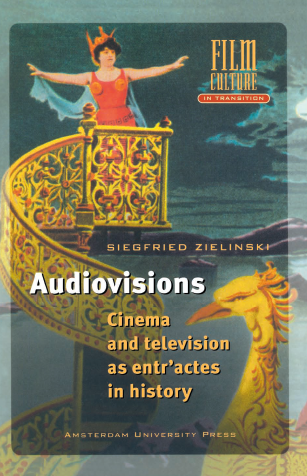Richard Abel, Rick Altman (eds.): The Sounds of Early Cinema (2001)
Filed under book | Tags: · cinema, film, film history, music, silent cinema, sound recording, theatre

The first book to examine the variety of sounds that accompanied so-called silent cinema.
The Sounds of Early Cinema is devoted exclusively to a little-known, yet absolutely crucial phenomenon: the ubiquitous presence of sound in early cinema. “Silent cinema” may rarely have been silent, but the sheer diversity of sound(s) and sound/image relations characterizing the first 20 years of moving picture exhibition can still astonish us. Whether instrumental, vocal, or mechanical, sound ranged from the improvised to the pre-arranged (as in scripts, scores, and cue sheets). The practice of mixing sounds with images differed widely, depending on the venue (the nickelodeon in Chicago versus the summer Chautauqua in rural Iowa, the music hall in London or Paris versus the newest palace cinema in New York City) as well as on the historical moment (a single venue might change radically, and many times, from 1906 to 1910).
Contributors include Richard Abel, Rick Altman, Edouard Arnoldy, Mats Björkin, Stephen Bottomore, Marta Braun, Jean Châteauvert, Ian Christie, Richard Crangle, Helen Day-Mayer, John Fullerton, Jane Gaines, André Gaudreault, Tom Gunning, François Jost, Charlie Keil, Jeff Klenotic, Germain Lacasse, Neil Lerner, Patrick Loughney, David Mayer, Domi-nique Nasta, Bernard Perron, Jacques Polet, Lauren Rabinovitz, Isabelle Raynauld, Herbert Reynolds, Gregory A. Waller, and Rashit M. Yangirov.
Richard Abel is Ellis and Nell Levitt Professor of English at Drake University, where he teaches cinema/media/cultural studies. His most recent book is The Red Rooster Scare: Making Cinema American, 1900-1910 (California, 1999), which was a finalist for the Kraszna-Krausz Moving Image Book Award. Currently he is editing the Routledge Encyclopedia of Early Cinema.
Rick Altman is Professor of Cinema and Comparative Literature at the University of Iowa. After publishing Film/Genre (British Film Institute, 1999), which won the SCS Katherine Singer Kovacs award, he edited a special issue of IRIS 27 (Spring 1999) on the “State of Sound Studies.” His current projects include a book on the silent cinema soundscape, a DVD devoted to illustrated song slides, and performances by his troupe, The Living Nickelodeon.
Publisher Indiana University Press, 2001
ISBN 0253214793, 9780253214799
327 pages
More info (publisher)
More info (google books)
PDF (updated on 2012-7-14)
Comment (0)Siegfried Zielinski: Audiovisions: Cinema and Television as Entr’actes in History (1989/1999)
Filed under book | Tags: · cinema, digital cinema, film, film history, television

“The production, distribution, and perception of moving images are undergoing a radical transformation. Ever-faster computers, digital technology, and microelectronic are joining forces to produce advanced audiovision -the media vanishing point of the 20th century. Very little will remain unchanged.
The classic institutions for the mediation of film – cinema and television – are revealed to be no more than interludes in the broader history of the audiovisual media. This book interprets these changes not simply as a cultural loss but also as a challenge: the new audiovisions have to be confronted squarely to make strategic intervention possible.
Audiovisions provides a historical underpinning for this active approach. Spanning 100 years, from the end of the 19th to the end of the 20th century, it reconstructs the complex genesis of cinema and television as historically relative – and thus finite – cultural forms, focussing on the dynamics and tension in the interaction between the apparatus and its uses. The book is also a plea for “staying power” in studies of cultural technology and technological culture of film.
Essayistic in style, it dispenses with complicated cross references and, instead, is structured around distinct historical phases. Montages of images and text provide supplemental information, contrast, and comment.”
Originally published as Audiovisionen: Kino und Fernsehen als Zwischenspiele in der Geschichte, Rowohlt, Reinbek bei Hamburg, 1989.
Publisher Amsterdam University Press, 1999
Film Culture in Transition series
ISBN 9789053563137
360 pages
PDF (57 MB, no OCR)
PDF (14 MB, OCR, updated on 2016-7-18)
Frances Guerin: A Culture of Light: Cinema and Technology in 1920s Germany (2005)
Filed under book | Tags: · 1920s, cinema, film, film history, germany, silent cinema, technology, weimar republic

Cinema is a medium of light. And during Weimar Germany’s advance to technological modernity, light – particularly the representational possibilities of electrical light – became the link between the cinema screen and the rapid changes that were transforming German life.
In Frances Guerin’s compelling history of German silent cinema of the 1920s, the innovative use of light is the pivot around which a new conception of a national cinema, and a national culture emerges. Guerin depicts a nocturnal Germany suffused with light – electric billboards, storefronts, police searchlights – and shows how this element of the mise-en-scene came to reflect both the opportunities and the anxieties surrounding modernity and democracy. Guerin’s interpretations center on use of light in films such as Schatten (1923), Variete (1925), Metropolis (1926), and Der Golem (1920). In these films we see how light is the substance of image composition, the structuring device of the narrative, and the central thematic concern.
This history relieves German films of the responsibility to explain the political and ideological instability of the period, an instability said to be the uncertain foundation of Nazism. In unlocking this dubious link, A Culture of Light redefines the field of German film scholarship.
Publisher University of Minnesota Press, 2005
ISBN 0816642869, 9780816642861
314 pages
PDF (updated on 2014-9-5)
Comment (1)
